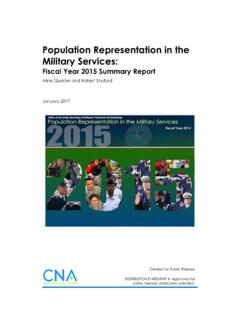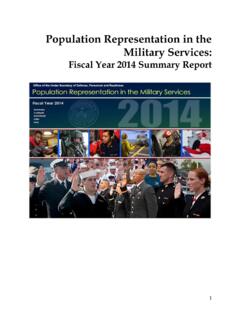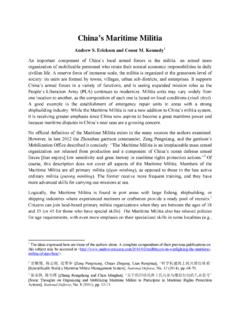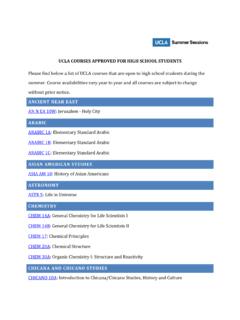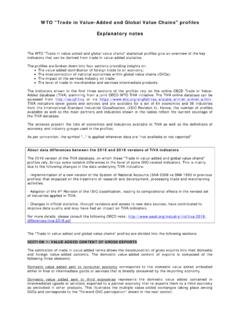Transcription of (U) Russian Forces in the Western Military District
1 IOP-2020-U-028759-1 Rev DISTRIBUTION STATEMENT A. Approved for public release: distribution unlimited. Cleared for public release June 2021 Russian Forces in the Western Military District Konrad Muzyka Rochan Consulting Copyright 2021 CNA Abstract In this CNA Occasional Paper, Konrad Muzyka provides an in-depth assessment of Russia s Western Military District , which consists of robust Forces spanning regions including St. Petersburg, Moscow, Kursk, and Kaliningrad. Muzyka s analysis provides an up-to-date overview of the current force structure and posture of this Military District , which underwent deep structural reforms between 2013 and 2019 to better address Western threats. These Forces include the 6th and 20th Combined Arms Armies, the 1st Guards Tank Army, three airborne divisions, the 6th Air and Air Defense Army, and a self-sufficient force in the Kaliningrad exclave.
2 Muzyka also discusses the Zapad-17 Military exercise, and provides assessments of ongoing modernization in the District . This report is part of a series generously funded by a grant from the Carnegie Corporation of New York. CNA s Occasional Paper series is published by CNA, but the opinions expressed are those of the author(s) and do not necessarily reflect the views of CNA or the Department of the Navy. Distribution DISTRIBUTION STATEMENT A. Approved for public release: distribution unlimited. 6/28/2021 This work was performed under Specific Authority Contract No. G-19-56503 Cover image credit: Пресс-служба Президента Российской Федерации [Press Service of the President of the Russian Federation], Совместные российско-белорусские стратегические учения Запад-2017 [Joint Russian -Belarusian strategic exercises "West-2017"], September 18, 2017, Approved by: June 2021 Michael Kofman, Research Program Director Russia Studies Program Strategy, Policy, Plans, and Programs Division Request additional copies of this document through CNA Occasional Paper | i Executive Summary This paper provides an updated order of battle assessment of existing units in Russia s Western Military District (mainland Russia and the Kaliningrad Oblast), analyzes roles assigned to them, and places Russian force posturing into a context of the post-2014 security situation.
3 It analyzes how the Russian armed Forces have developed their capabilities and how they have reorganized their Forces in the last six to eight years and, subsequently, how they have prepositioned their presence to address threats emanating from the Western operational direction. This is placed within the context of Military operations in Georgia and Ukraine as well as increased NATO presence in the Baltic States. The paper also examines scenarios practiced during the Zapad-17 strategic-operational exercise and efforts needed for Russia to fully engage in high-end, high-tempo combat operations in its immediate neighborhood. Although the document lists equipment that is fielded into specific units, it does not seek to provide a detailed table of organization and equipment (TO&E).
4 CNA Occasional Paper | ii This page intentionally left blank. CNA Occasional Paper | iii Contents Introduction .. 1 Methodology .. 2 The Western Military District An Overview .. 4 The 1st Guards Tank Army .. 9 The 6th Combined Arms Army .. 18 The 20th Combined Arms Army .. 22 Units Subordinate to the Western MD .. 24 Airborne Forces .. 28 The 6th Air and Air Defense Army .. 33 Fixed- and rotary-wing units .. 35 Air defense .. 38 The Kaliningrad Oblast .. 42 Ground components .. 43 Naval Forces .. 47 Air and air defense Forces .. 50 Ongoing Modernization, Finished Reform .. 52 Figures .. 55 Tables .. 56 Abbreviations .. 57 CNA Occasional Paper | iv This page intentionally left blank. CNA Occasional Paper | 1 Introduction Between 2013 and 2019, Russian Forces in the Western Military District (MD) underwent deep structural and organizational reforms to ensure that they are able to respond to a range of contingencies on Russia s Western borders.
5 Yet, there is little verified information in open sources on the full structure of units deployed to guard the Russian Western flank. What has driven reorganization and rearmament in the Western MD? Where are the units deployed? What missions are assigned to front-level and operational-level units? How have reforms affected the ability to conduct all-arms warfighting operations? In 2012, the Russian ground force presence in the Western parts of the country was scant. Land Forces fielded the 6th and 20th Combined Arms Armies, with the latter one deployed in Mulino, 350 km (217 miles) east of Moscow. These two operational-level units generated field four motor rifle brigades (MRBs) and two tank Even though two additional MRBs under MD s command provided supplementary firepower, maneuverability, and flexibility, it is fair to say that this part of Russia was insufficiently protected.
6 These deficiencies stemmed from a rather benign view on threats to the Russian Military security, which did not assume any immediate threats. The expansion of Military presence in the Western MD and its reorganization commenced with the departure of the deeply unpopular minister of defense, Analoty Serdiukov, in 2012. The advent of Sergei Shoigu as Serdiukov s replacement paved the way for a gradual reintroduction of more robust Forces into the District , which manifested in the reestablishment of the 1st Guards Tank Army in 2013. Since then, modernization and reorganization processes have swept across the District , also largely as a consequence of the Russian Military involvement in Ukraine. Since 1991, main organizational reforms seem to have concluded and Russian Forces in the Western MD have never been more capable.
7 This is seen through the deliveries of new equipment, increased readiness, expanded force structure, combined-arms exercises, and enlarged and improved combat support service and logistics. Although the defense of the homeland seems to be the primary mission, Forces in the Western MD have a plethora of 1 Shinji Hyodo and Carolina Vendil Pallin (eds.), Neighbourhood Watch: Japanese and Swedish perspectives on Russian security, FOI, Oct. 2012, p. 60, CNA Occasional Paper | 2 capabilities to engage in offensive operations in Russia s neighborhood and quickly deliver a preponderance of power to deliver a swift victory. This, combined with the willingness to use force in order to achieve foreign policy objectives (Georgia, Ukraine, Syria) have raised concerns in NATO as to the real goals of Russian Military modernization in general, and in the Western MD in particular.
8 This was particularly evident in the run-up to the 2017 iteration of the Zapad strategic-operational This study seeks to present the reader with an up-to-date assessment of the Russian force posture and structure in the Western MD. In doing so, it will present an analysis of the 1st Guards Tank Army, the 6th and 20th Combined Arms Armies, and units directly under the MD command. Next, the paper will analyze assets belonging to the 6th Air and Air Defense Army, which is tasked with air defense duties over Western Russia. Finally, the analysis will focus on the Russian Forces in the Kaliningrad Oblast, which have also been subjected to reform and modernization in recent years. Methodology We obtained data on locations of Military bases and units from a variety of Russian sources. These included business registries, regional and city-level news outlets, Russian Orthodox Church websites, regional eparchies (in particular), and the registry of trial proceedings.
9 To confirm unit identity and subordination, we used an analysis of badges and insignia worn on soldiers sleeves or displayed on Military events. Information about maintenance work on power grids, water, and sewage systems also provided high-quality confirmation about the location of Military units, as did tenders for planned construction works at Military facilities. Another source was regional enlistment offices, which publish information about units that require contract servicemembers; they provided the unit number and the name of the city where the unit is based. Google Street View, and its Russian equivalent, Yandex Panoramas, also provided recent views of Military facilities, predominantly in urban areas, which helped pinpoint the location of Military bases and facilities. Finally, we checked every location using commercially available satellite imagery, to confirm whether there was movement within bases and thus whether the base was still active.
10 2 Simon Saradzhyan, 100,000 troops will engage in Russia's Zapad-2017 war games, , 13 Sept. 2017, CNA Occasional Paper | 3 All this helped confirm the existence of around 200 units in the Western Military District . This number excludes Military storage facilities, Strategic Rocket Forces bases, and units belonging to Long-Range and Military Transport Aviation, which, because of their capabilities and ranges, can conduct operations across the entire country. CNA Occasional Paper | 4 The Western Military District An Overview Out of all the Military districts, Russia s Western Military District (MD) fields the most robust, most numerous, and most capable fighting Forces . Strengthening the Western operational direction remains the priority for Moscow: it considers threats emanating from the west to be the most severe threats that can ultimately endanger the Military security and thus the existence of the Russian Figure 1, on the following page, shows the Western MD.

